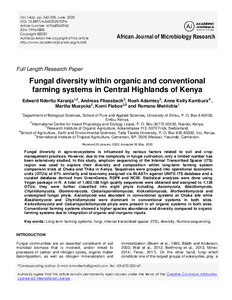| dc.contributor.author | Karanja, E.N. |
| dc.contributor.author | Fliessbach, A. |
| dc.contributor.author | Adamtey, N. |
| dc.contributor.author | Kambura, A.K. |
| dc.contributor.author | Musyoka, M. |
| dc.contributor.author | Fiaboe, K. |
| dc.contributor.author | Mwirichia, R. |
| dc.date.accessioned | 2022-08-19T08:11:31Z |
| dc.date.available | 2022-08-19T08:11:31Z |
| dc.date.issued | 2020 |
| dc.identifier.citation | Karanja, E.N., Fliessbach, A., Adamtey, N., Kambura, A.K., Musyoka, M., Fiaboe, K. & Mwirichia, R. (2020). Fungal diversity within organic and conventional farming systems in Central Highlands of Kenya. African Journal of Microbiology Research, 14(6), 242-258. |
| dc.identifier.issn | 1996-0808 |
| dc.identifier.uri | https://hdl.handle.net/20.500.12478/7662 |
| dc.description.abstract | Fungal diversity in agro-ecosystems is influenced by various factors related to soil and crop management practices. However, due to the complexity in fungal cultivation, only a limited number has been extensively studied. In this study, amplicon sequencing of the Internal Transcribed Spacer (ITS) region was used to explore their diversity and composition within long-term farming system comparison trials at Chuka and Thika in Kenya. Sequences were grouped into operational taxonomic units (OTUs) at 97% similarity and taxonomy assigned via BLASTn against UNITE ITS database and a curated database derived from GreenGenes, RDPII and NCBI. Statistical analyses were done using Vegan package in R. A total of 1,002,188 high quality sequences were obtained and assigned to 1,128 OTUs; they were further classified into eight phyla including Ascomycota, Basidiomycota, Chytridiomycota, Glomeromycota, Calcarisporiellomycota, Kickxellomycota, Mortierellomycota and unassigned fungal phyla. Ascomycota was abundant in conventional systems at Chuka site while Basidiomycota and Chytridiomycota were dominant in conventional systems in both sites. Kickxellomycota and Calcarisporiellomycota phyla were present in all organic systems in both sites. Conventional farming systems showed a higher species abundance and diversity compared to organic farming systems due to integration of organic and inorganic inputs. |
| dc.description.sponsorship | UKAid |
| dc.description.sponsorship | United Kingdom Government |
| dc.description.sponsorship | Swedish International Development Cooperation Agency |
| dc.description.sponsorship | Swiss Agency for Development and Cooperation |
| dc.description.sponsorship | Federal Democratic Republic of Ethiopia |
| dc.description.sponsorship | Kenyan Government |
| dc.format.extent | 242-258 |
| dc.language.iso | en |
| dc.subject | Farming Systems |
| dc.subject | Fungi |
| dc.subject | Sequence Experiments |
| dc.subject | Kenya |
| dc.title | Fungal diversity within organic and conventional farming systems in Central Highlands of Kenya |
| dc.type | Journal Article |
| cg.contributor.crp | Roots, Tubers and Bananas |
| cg.contributor.affiliation | University of Embu |
| cg.contributor.affiliation | International Centre of Insect Physiology and Ecology |
| cg.contributor.affiliation | Research Institute of Organic Agriculture, Switzerland |
| cg.contributor.affiliation | Taita Taveta University |
| cg.contributor.affiliation | International Institute of Tropical Agriculture |
| cg.coverage.region | Africa |
| cg.coverage.region | East Africa |
| cg.coverage.country | Kenya |
| cg.coverage.hub | Central Africa Hub |
| cg.researchtheme | Natural Resource Management |
| cg.identifier.bibtexciteid | KARANJA:2020 |
| cg.authorship.types | CGIAR and developing country institute |
| cg.iitasubject | Farming Systems |
| cg.iitasubject | Plant Breeding |
| cg.iitasubject | Plant Health |
| cg.iitasubject | Plant Production |
| cg.journal | African Journal of Microbiology Research |
| cg.notes | Published online: 30 June 2020 |
| cg.accessibilitystatus | Open Access |
| cg.reviewstatus | Peer Review |
| cg.usagerightslicense | Creative Commons Attribution 4.0 (CC BY 0.0) |
| cg.targetaudience | Scientists |
| cg.identifier.doi | https://dx.doi.org/10.5897/ajmr2020.9294 |
| cg.futureupdate.required | No |
| cg.identifier.issue | 6 |
| cg.identifier.volume | 14 |

